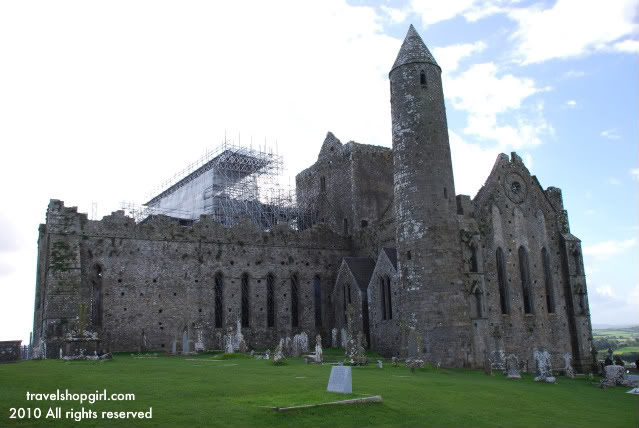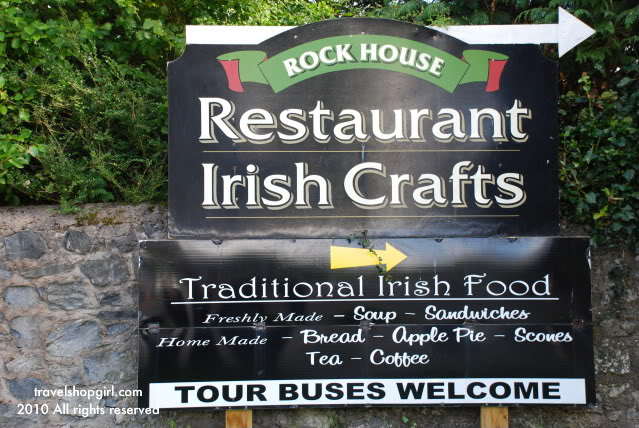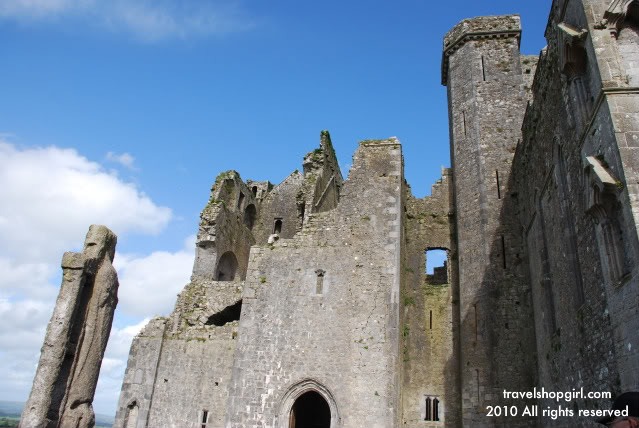FYI: the family rate is for two adults and two children. Admission includes a movie with information and a self-tour of the castle and grounds. Anyone with mobility issues might want to reconsider visiting as there are many stairs to climb to enter the main building although I did spot a handicapped sign just past the regular entrance. It is a climb to get to the entrance so you might want to consider dropping off the elderly or anyone with a small child at the entrance and then parking in the car park.
The Rock of Cashel was the traditional seat of the kings of Munster for several hundred years prior to the Norman invasion. Few remnants of the early structures survive; the majority of buildings on the current site date from the 12th and 13th centuries. Cashel is reputed to be the site of the conversion of the King of Munster by St. Patrick in the 5th century. The picturesque complex has a character of its own and is one of the most remarkable collections of Celtic art and medieval architecture to be found anywhere in Europe.
According to local mythology, the Rock of Cashel originated in the Devil’s Bit, a mountain 30 km north of Cashel when St. Patrick banished Satan from a cave, resulting in the Rock’s landing in Cashel.
The oldest and tallest of the buildings is the well preserved round tower (28 metres, or 90 feet), which dates from c.1100. Its entrance is 12 feet from the ground, necessitated by a shallow foundation (about 3 feet) typical of round towers. The tower was built using the dry stone method. Modern conservationists have filled in some of the tower with mortar for safety reasons.
Cormac’s Chapel, the chapel of King Cormac Mac Carthaigh, was begun in 1127 and consecrated in 1134. It is a very sophisticated structure, unlike most Irish Romanesque churches, which are ordinarily simple in plan with isolated decorated features. The Abbot of Regensburg sent two of his carpenters to help in the work and the twin towers on either side of the junction of the nave and chancel are strongly suggestive of their Germanic influence, as this feature is otherwise unknown in Ireland. Other notable features of the building include interior and exterior arcading, a barrel-vaulted roof, a carved tympanum over both doorways, the magnificent north doorway and chancel arch. It also contains one of the best preserved Irish frescos from this time period.
The Cathedral, built between 1235 and 1270, is an aisle-less building of cruciform plan, having a central tower and terminating westwards in a massive residential castle. The Hall of the Vicars Choral was built in the fifteenth century. The vicars choral were laymen (sometimes minor canons) appointed to assist in chanting the cathedral services. At Cashel there were originally eight vicars choral with their own seal. This was later reduced to five honorary vicars choral who appointed singing-men as their deputies, a practice which continued until 1836. The restoration of the Hall was undertaken by the Office of Public Works as a project in connection with the European Architectural Heritage Year, 1975. Through it visitors now enter the site.
In 1749 the main cathedral roof was removed by Arthur Price, Bishop of Cashel.
This is a view looking outward toward the lush, green Ireland hillside and one of the crosses.
The entire plateau atop the rock, on which the buildings and graveyard lie, is walled. In the grounds around the buildings an extensive graveyard includes a number of high crosses. Scully’s Cross, one of the largest and most famous high crosses on Cashel, originally constructed in 1867 to commemorate the Scully family, was destroyed in 1976 when lightning struck a metal rod that ran the length of the cross. The remains of the top of the cross now lie at the base of the cross adjacent to the rock wall.
Overall, everyone in our group (my husband, 16-year old son, mother-in-law, and father-in-law) enjoyed our visit to Rock of Cashel. Between the history, artifacts, and open air after sitting in the car for while, it was a great break before heading to Cobh.














